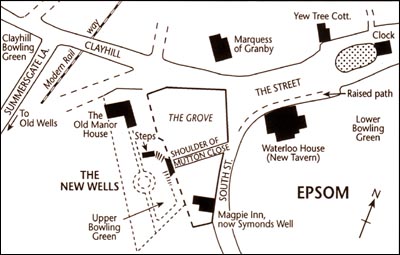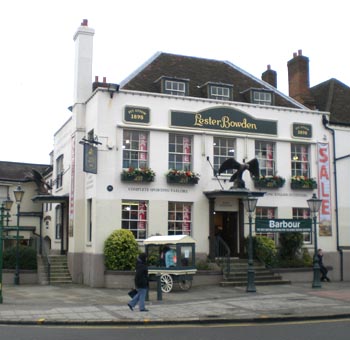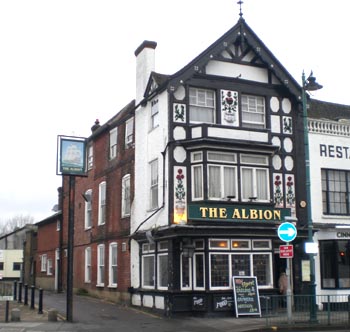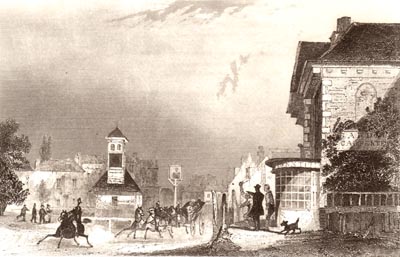
HOME





HOME
|

|

|

|

|
|
P R O F I L E |
||||
|
  www.EpsomWells.com
www.EpsomWells.comEPSOM AND EWELL WELLS - Chapter 6An Era of Expansion (1690-1712) Dr Bruce E Osborne An Era of Expansion (1690-1712): Livingstone, the New Wells, further town development, visitors, Old Wells improved. 6.1 Livingstone's New Wells, after Clark (1960). The evolving commercial infrastructure of Epsom was typical of the principal spas of the time. Tunbridge developed a new shopping “mall” in 1687 following a fire that destroyed some primitive structures. The continuous colonnade later became known as The Pantiles, Bristol benefited from Hotwell House in 1696 and Bath built a new pump room in 1706. Such expansion typified the new commercial approach to spa development which came about following the unsettled times of the Interregnum and subsequent religious fluctuations of the monarchy. A new confidence was apparent and private capital was an essential component in providing facilities that were to attract spa visitors. There is no doubt that Celia Fiennes, who visited Epsom first in about 1690, was attracted to such entrepreneurialism and she in turn invested in a new rock salt mine on the Marbury Estate at Northwich.[1] The increasing importance of Epsom Spa at this time is apparent in Edmund Gibson's 1695 translation of Camden's Britannica, which commented on the town in an Addendum. It noted “those medicinal wells that rise on the common”, thereby confirming that there were more than one, contained "allom" and there had recently been considerable development in the parish as a result of the growing reputation of the Spaw.[2] Critical to the evolution of Epsom was what happened during that vital period between Celia Fiennes' first and second journals of the town and spa. Her first observations were made in the early 1790s and have been covered in Chapter 5. Her second journalised visit was in 1712. This period of transition saw the traditional order replaced with entrepreneurialism although it has been shown that infrastructure investment to accommodate tourists was starting to occur within the town during the second half of the seventeenth century. This earlier investment appears to have been demand-led, whereas it was proactive marketing for expanded tourism through innovation that typified the transition period. Hampstead underwent a contemporaneous era of capitalist expansion as entrepreneurs moved in to develop commercial spa enterprises. For Epsom there were two leading spa entrepreneurs, John Parkhurst developed the wells on the common, to become known as the Old Wells, and one John Livingstone created the New Wells. It was in 1692 that Livingstone, an apothecary, started to make an impact on the local community. Having come to Epsom in about 1690, he was appointed as one of two Tithingmen.[3] In 1695 Livingstone lent £150 secured against a property in Church Street, at the eastern end of the town. Later in 1699, he became the authorised copyholder of the property but never developed it.[4] The key to Epsom’s development however lay with the lord of the manor. Lady Evelyn held courts until 1691 and died in 1692. The manorial estate was then managed by the Buckles of Banstead as Trustees to Ann, Lady Evelyn's sister. The elderly Lady Evelyn and then the “absentee” manorialship of the Buckles had not provided an active leadership for economic development. On Ann's death in 1706, John Parkhurst of Northants inherited the manor.[5] This event endorsed Parkhurst's serious interest in Epsom, and he thereafter provided an environment for investment in the town. The manor also endorsed Livingstone’s activities through the manorial courts as well as taking its own initiatives, once a more dynamic lord was in situ. As a measure of the town's repute in 1697, 2000 people a day visited Epsom. This comment comes from Grew to illustrate the popularity of Epsom once physicians had recommended the salts.[6] In 1701 there were signs that John Livingstone, the apothecary, was considering developing the western end of the town, while John Parkhurst, lord of the manor, appears to have developed the (Old) Wells on the common shortly after. John Livingstone bought a house on a triangular piece of land of about a quarter of an acre in Shoulder of Mutton Close, at the end of the High Street. A coachman, one W. Parkhurst had previously erected a house on this site between 1680 and 1686. Livingstone also acquired two small abutting plots. These were all to become "The Grove".[7] Shoulder of Mutton Close had previously been part of Humphrey Beane's estate and it has been erroneously suggested that Livingstone's acquisition included the lease of land with a well from John Symonds.[8] Symonds' property was immediately to the south but the location of any well uncertain. About this time the manor in the form of John Parkhurst or perhaps the earlier Buckles, laid out the town with avenues of trees and built a spa ballroom, 70 feet long at the (Old) Wells. A brick wall with coping surrounded the land.[9] There is some confusion as to the precise date that Parkhurst first embarked on his development schemes. The dating of the ballroom as 1690 in the 1769 Lloyds Evening Post is suspect. Parkhurst's first court was held in 1707, prior to this the Buckles of Banstead held the courts as trustees to Lady Evelyn's will. A date of 1690 raises the question: did Parkhurst lay out the town 17 years before coming lord of the manor? It is unlikely. Furthermore, Celia Fiennes did not comment on the improved facilities until her second narration of 1712; her first narration of the early 1690s made no report of Parkhurst's improvements. It is probable therefore that Parkhurst's developments took place about 1707. He then leased out the facilities. Whilst John Parkhurst was developing the town and the (Old) Wells on the common, John Livingstone supposedly sank a new town well and developed a pump room as part of a development program.[10] The precise location of this pump room and well is uncertain other than the well supplied the pump room at his facilities at the western end of town. When the house known as the Manor House, which is in the vicinity, was modernised, beneath the floor of the old kitchen, which was to be converted to the dining room, was a well with pipes. This may have been Livingstone's original well[11] although the Warrens or Symonds Well is a more likely alternative candidate, a point discussed later. Livingstone's new facility, being far more convenient to the town, was a serious rival to John Parkhurst's Old Wells out on the common. It may have been that the New Wells development prompted Parkhurst to improve the Old Wells. Various authors give testimony to Livingstone's activities at this time. Sunderland records that, c.1706, Livingstone purchased land and erected a ballroom, gambling room, shops and houses as a business speculation.[12] This would have been adjacent to land previously purchased in 1701 and developed as The Grove. Home notes that Livingstone planted a grove and laid out a bowling green at the end of which he sank a well with a pump. By means of pipes the water was conveyed to the assembly room. The development took about two years to complete and was named the "New Wells".[13] Lehmann gives considerably more detail about the relationship between Livingstone and Parkhurst and it is apparent that in 1707, when John Parkhurst become lord of the manor, inheriting it under the will of Lady Evelyn, he was working in tandem with Livingstone. Prior to this Parkhurst's history had included some dubious transactions leading to a spell in The Tower. In Parkhurst's first manorial court it is recorded that Livingstone disposed of his earlier purchase, the Church Street property. In addition the manorial records confirm Livingstone's acquisition, from John Castleton and Sir John Parsons, of a piece of land to the westward of the plots purchased by Livingstone earlier in 1701. Both acquisitions were once part of the Beane estate. The 1701 land was developed by 1707 as The Grove. The additional property, purchased in 1707, already contained buildings and a bowling green and was functioning as the New Wells together with Livingstone's adjacent Grove. Livingstone had actually developed the 1707 property before formal acquisition as a result of an arrangement with Anne Emerson, the tenant. Livingstone's entitlement to be on the land was somewhat dubious and Parkhurst's first manorial courts of 1707/8 enabled Livingstone to secure his position.[14] Often such pre-empting of the final legal agreement came about as a result of the slowness of the legal profession. A similar circumstance is recorded at Hampstead Wells about the same time.[15] In 1707 the New Wells opened on the 25 April, seven months before Livingstone actually secured his legal title to the land.[16] From Clark's researches it has been possible to piece together a detailed picture of Livingstone's New Wells. The site was a substantial one between the modern West Street and South Street, at the western end of the High Street, east of the later railway. The site is mapped by Clark (1960) showing the location of the Upper Green, the Manor House and the Grove. An advertisement for the New Wells appeared in the Daily Courant at this time. The waters were free and shops were to let.[17] With the new facilities came the promotion and publicity. A guide book in French, produced in Holland by James Beeverell in 1707, mentions Ebbesham or Epsom as being famous for its mineral waters. Whilst the purging was a source of health for some, the waters also serve as a pretext to join parties for entertainment. The later 1727 edition incidentally places greater emphasis on healthy air and entertainment, which is indicative how the appeal was to shift in the 18th century.[18] With two centres for drinking the waters, the Old and New Wells, rivalry was inevitable. In 1710, a German traveller, Von Uffenbach visited Epsom for the horse racing, using Beeverell's guidebook. His journal was published in Germany in 1753. Visiting the Old Well he drank the water from nasty stoneware jugs, three pints at a time. He also visited the New Wells, commenting that the waters were very similar.[19] Livingstone appears to have been intent on further securing his position by establishing a monopoly on the mineral waters. In 1711 he supposedly secured the leases on the Old Well, having first engineered a further 21 years extension through the vendors. This done, Livingstone took over the Old Wells which Parkhurst had developed over recent years.[20] The basis for this supposition is the Lloyds Evening Post article of 1769.[21] As the article contained inaccuracies it may also be suspect in this respect.[22] Celia Fiennes in 1712 noted that the upper green was kept by the same man as The Wells. This confirms the acquisition of the Old Wells lease by Livingstone and that both wells remained available at the same time. Another visitor at this time was Johann Philipp Seip. He visited Dr Martin Lister at Epsom in June 1711. When he inquired where the large quantities of Epsom Salts came from he was informed that it was supplied by chemists in London, none being produced locally.[23] The significance of this observation will be demonstrated in later text. 
6.2 The Spread Eagle is an early building dating from the spa era that has survived. The town was developing fast and it was between 1710 and 1716 that one Henry North made the Black Spread Eagle a going concern. A valuable general description of Epsom around 1711 comes from John Toland.[24] Living at Woodcote, he wrote that the waters were beneficial in gently cleansing the body, in cooling the head and purifying the blood. Doctors were advocating pleasure as a cure rather than taking the waters. Toland observed above sixty coaches on the ring on the Downs on a Sunday evening. There was by this time the new curvilinear racecourse that had replaced the 4-mile straight course down to Banstead Downs, albeit the grandstand remained in the same position, at the winning post.[25] He also commented on the plentiful supply of good food, especially Banstead-down Mutton.[26] Only two to three hours from London meant that commuting was relatively easy. There were topiary porticos and a tiled terrace at Epsom, no doubt similar to The Pantiles at Tunbridge Wells.[27] Two rival bowling greens were mentioned. The Old Wells, a half mile away were not so much in vogue, the waters of the "village" being as good. The cold bath, lately erected, was also less popular and he suggested relocating it at Ewell where it could benefit from a more copious supply of water. The Watch House in the High Street was mentioned by Toland and surviving illustrations confirm that it had a turret with a clock, a fact noted by Celia Fiennes in her second report of Epsom.[28] We can see therefore that by Celia's second narration of 1712, Epsom was a prospering spa enjoying the benefits of capital investment in infrastructure. Livingstone's New Wells were a success and he secured his position by taking over the Old Wells. The precise whereabouts of Livingstone's new mineral water source remains a mystery. There is little contemporary evidence that it was anything other than a perfectly adequate source of the mineral waters. It was after Celia Fiennes' second visitation that the scene was to change considerably. Celia Fiennes Second Visit How different Epsom was on her later visit, which is dated about 1712, compared with her first. In the second narration of Epsom, Celia Fiennes described the facilities in the town more extensively[29] and noted the curious cut hedges and trees. Durdans was by then "Lord Guilford's". She observed the great tavern and eating house on this later visit, implying that the establishment has improved and new facilities. This is the New Tavern/Assembly Rooms, later Waterloo House. Mention of a visit to the Old Wells suggests that at this point in time the Old Wells were still functioning as a spa.[30] The social focus of the time was definitely the town centre and the trip to the Old Wells to take the waters was a less significant part of the proceedings. 
6.3 The Albion Hotel was a coffee house during the spa era adjacent to the New Wells. The present name dates from the 19th century. It is part of a group of surviving buildings at 128-132 High Street. Celia observed that the Wells (meaning the Old Wells on the common) were now built about with a large light room to walk in, with a pump put on the well. She does not appear to have taken the waters. A coffee house, gaming rooms and sweetmeats and fruit shops were included in the facilities. There was even organised entertainment with racing of boys, rabbits and pigs. In the town, two greens were used for evening recreation. The Upper Green was kept by the same man as the Wells (Livingstone) and included benches to sit, shops and a gaming or dance room. The Lower Green, in the town centre, was generally warmer, and facilities included a very large room with sash windows with cushions in the windows, two hazard-boards and shops all belonging to the great tavern or eating house. The presence of the large room and a piazza walk with topiary-cut trees suggests that there was a promenade for walking, similar to Tunbridge Wells. A clock was reported at the "Crosse in the streete".[31]  6.4 Early Epsom showing the clock in the High Street and the New Tavern to the right.
6.4 Early Epsom showing the clock in the High Street and the New Tavern to the right.
Comment on Celia Fiennes second narration Clark, in his 1954 paper, suggested a date for this narration of about 1710 but revised it to later, based on the date of 1716 for the erection of the new New Inn.[32] Clark however was apparently confused on this point.[33] The first New Inn was on the Hylands House, but the name was, in 1717, transferred to what is now the White Horse public house in Dorking Road and not the building known as The New Tavern/Assembly Rooms, later Waterloo House in the High Street.[34] The New Tavern main complex was erected in 1692[35] and later described in Lloyd's Evening Post (1769) as the largest tavern in England. When erected the building comprised buildings around an open courtyard with a through carriageway, subsequently blocked. There was a long room, known as The Great Room on the ground floor. This was used for gambling. On the first floor was the substantial Dancing or Supper Room. Behind there was a bowling green, cockpit and gardens. Included in the facilities was a coffeehouse and tavern.[36] There is also the suggestion of a theatre there by 1708 run by Mrs Mynn.[37] At the time of Celia's second visit Durdans was Lord Guilford's which dates this account after 1708 when John, the Duke of Argyle purchased it. Durdans was then sold by 1712 when Clark, quoting Victoria County History, reported that it was in the hands of Lord Guilford.[38] Furniss confirms the date citing Lord North as the purchaser.[39] This is easily explained; the Lords North were conferred with the Earldom of Guilford. The family was active in the discovery of both Epsom and Tunbridge Wells spa waters.[40] Toland's 1726 description of Epsom further confirmed Durdans was in the hands of Lord Guilford although Toland's original 1711 text did not.[41] A date of 1712 or shortly after is likely realistic for Celia's account. 6.5 The New Inn or Tavern 1706. Morris, who edited the Fiennes’ diaries, observed that Celia Fiennes visited the spas more often than she related; she was most familiar with Epsom noting the growth of the weekend habit there.[42] Some aspects of her diary may therefore be difficult to date with precision as it may have been written based on experiences over an extended period of time. Livingstone likely kept the Old Wells open for a while after securing the leases in 1711, certainly they were open when Celia Fiennes made her second visit.[43] Without doubt the improving facilities in the town as well as the inconvenient location of the Old Wells, was leading to the reduced popularity of the latter. It is known from other documentary sources that the Old Wells had proved unreliable and that Epsom Salts were readily available in town, either from the apothecaries’ or the New Wells. In the full account of her second visit to Epsom, Celia was enthusiastic about the enhanced facilities that she found in the town. The great attraction for Celia in Epsom was the houses of the wealthy by this time. There had been much development that was not present on her earlier visits and this later second journal was prepared because of the substantial change. Fortunately both have survived to give a unique insight into Epsom over this critical period. Click on website below to return to Index and Introduction. Website: Click Here ADDITIONAL INFORMATION Illustrations: 6.1. Livingstone's New Wells, after Clark (1960). 6.2. The Spread Eagle is an early building dating from the spa era that has survived. 6.3. The Albion Hotel was a coffee house during the spa era adjacent to the New Wells. The present name dates from the 19th century. It is part of a group of surviving buildings at 128-132 High Street. 6.4. Early Epsom showing the clock in the High Street and the New Tavern to the right. 6.5. The New Inn or Tavern 1706. References: [1] Morris C. (1947) The Journeys of Celia Fiennes, Cresset Press, London, p.224, footnote and xxi. [2] Lehmann H L. (1973) “The History of Epsom Spa” Surrey Archaeological Collections, SAS, LXIX, p.90. [3] Exwood M. (1989) Epsom Wells, Epsom & Ewell Borough Council, p.17. [4] Clark F L. (1960) The History of Epsom Spa, Surrey Archaeological Collections, SAS. Vol.57. p.9. [5] Malden H E. ed., (1911) A History of Surrey, Victoria History of the Counties of England, Vol.III, Constable & Co. London, p.274. [6] Kirkby W. (1902) The Evolution of Natural Mineral Waters, Jewsbury and Brown, Manchester, p.11; Exwood M. (1989) p14. [7] Lehmann H L. (1987) The Residential Copyholds of Epsom, Epsom and Ewell Borough Council, ref. 1B13; Clark F L. (1960) p.13. [8] Anon. (1995) The Discovery of Symonds Well, publicity communication, Symonds Well Restaurant, Epsom. [9] Addison W. (1951) English Spas, Batsford, p.16; Home G. (1901) Epsom, Its History and its Surroundings, 1971 ed., SR Printers Yorkshire, Ch.III. [10] Addison W. (1951) p.17. [11] Clark F L. (1960) p.15-20. [12] Sunderland S. (1915) Old London’s Spas, Baths and Wells, John Bale, London, p.140. [13] Home G. (1901) Ch.III. [14] Lehmann H L. (1987) ref.1B7. [15] Potter G W. (1904) Hampstead Wells, George Bull & Sons, p.49. [16] Clark F L. (1960) p.18. [17] Exwood M. (1989) p.18; Lennard R. (1931) “The Watering Places” Englishmen at Rest and Play, Oxford, p.63. [18] typescript from Bourne Hall Museum, p.6. [19] Sakula A. (1983) “The Waters of Epsom Spa”, Surrey History, Vol.2, No.5, Phillimore, Chichester, p.234; Exwood M. (1986) typescript from Bourne Hall Museum, p.7. [20] Clark F L. (1960) p.28. [21] a précis is produced by Exwood M. (1989) p.40-42. [22] Exwood M. (1989) p.26,40/1. [23] Exwood M. undated typescript, Bourne Hall Museum. [24] Toland J. (1711) The Description of Epsom, facsimile edition by Silverstone L C. (1978) Derek James, Sutton. Also reproduced by Aubrey J. (1718) Natural History and Antiquities of the County of Surrey, Vol.II, 1975 reprint, Kohler and Coombes, Dorking, p.197-213. Home G. (1901) reproduces the 1726 version text, p.51/7. [25] Malden H E. ed., (1911) A History of Surrey, Victoria History of the Counties of England, Vol.III, Constable & Co. London, p.272. [26] Sunderland S. (1915) p.140/1. [27] Addison W. (1951) p.18. [28] Home G. (1901) Ch.III, p.58; Toland J. (1711) 1-35. [29] Morris C. (1947) p.341-351. [30] Clark F L. (1960) p.29. [31] Morris C. (1947) p.349/50; Clark F L. (1954) New Light on Epsom Wells, Pullingers, Epsom, p.12-20. [32] Clark F L. (1960) p.29. [33] Exwood M. (1989) p.15,19. [34] Nail N. (1999) Waterloo House, Nonsuch Antiquarian Society, Occasional Paper no. 37, p.9; Harte J (1999) personal communication. [35] Abdy C. (1997) Building Meets its Waterloo, Guardian (local), 27 Feb., p.6. [36] Abdy C. 1999, Epsom Spa, Nonsuch Antiquarian Society Newsletter, 1/99, p.5. [37] Furniss J. (1992) Epsom Talk of the Town, Bath Press Ltd., p.42. [38] Morris C. (1947) p.342; Clark F L. (1954) p.13/4. [39] Furniss J. (1992) Epsom, Talk of the Town, Bath Press, p.29. [40] Osborne B. Weaver C. (1996) Rediscovering 17th Century Springs and Spas in the Footsteps of Celia Fiennes, Cora Weaver, Malvern, p.14/5. [41] Toland J. (1711) p.29; Home G. 1901, see Toland's 1726 text, p.51-57. [42] Morris C. (1947) p.xxviii. [43] Clark F L. (1960) p.29. |
||||
|